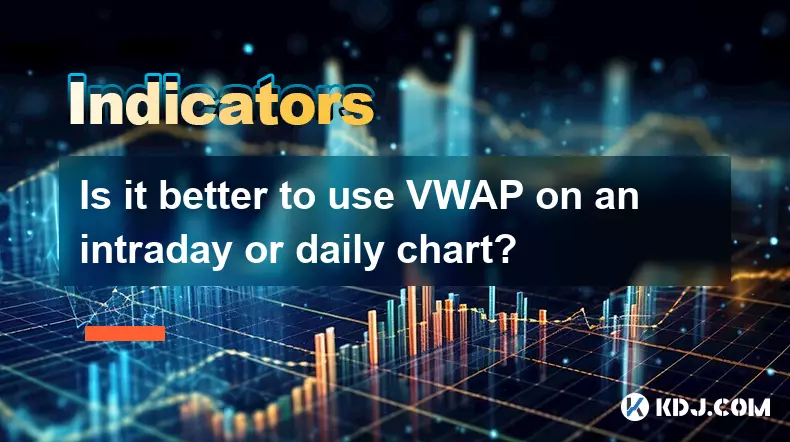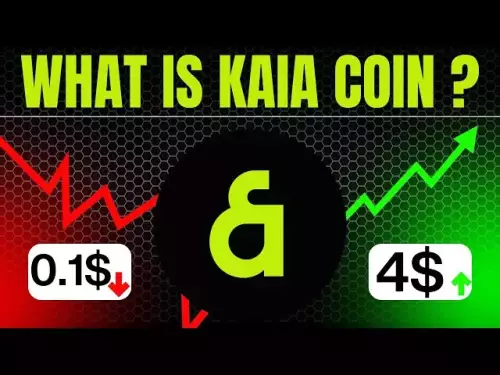-
 bitcoin
bitcoin $112715.707551 USD
-1.71% -
 ethereum
ethereum $4101.475385 USD
-3.01% -
 tether
tether $1.000644 USD
-0.02% -
 bnb
bnb $1207.619465 USD
-6.77% -
 xrp
xrp $2.501451 USD
-3.98% -
 solana
solana $202.947124 USD
-3.32% -
 usd-coin
usd-coin $1.000295 USD
0.04% -
 dogecoin
dogecoin $0.203884 USD
-4.47% -
 tron
tron $0.317154 USD
-1.72% -
 cardano
cardano $0.695009 USD
-4.43% -
 hyperliquid
hyperliquid $38.853961 USD
-8.23% -
 chainlink
chainlink $18.988674 USD
-4.64% -
 ethena-usde
ethena-usde $1.000233 USD
-0.03% -
 stellar
stellar $0.337050 USD
-3.63% -
 bitcoin-cash
bitcoin-cash $536.861728 USD
-1.28%
Can the KDJ indicator predict market tops and bottoms?
The KDJ indicator helps crypto traders spot overbought/oversold conditions and potential reversals using K, D, and J lines, but works best when combined with volume, trend analysis, and other technical tools to filter false signals in volatile markets.
Oct 12, 2025 at 08:54 am

Understanding the KDJ Indicator in Cryptocurrency Trading
The KDJ indicator, a variation of the stochastic oscillator, is widely used by traders in the cryptocurrency market to identify potential turning points. It consists of three lines: K (fast stochastic), D (slow stochastic), and J (divergence). These values are derived from price momentum over a specific period, typically 9 days, and oscillate between 0 and 100. Traders rely on this tool to detect overbought or oversold conditions within volatile digital asset markets.
1. The K line reflects the current closing price relative to the recent trading range, offering immediate signals about momentum shifts.
- The D line acts as a signal line for the K line, smoothing out fluctuations to reduce false readings.
- The J line measures the distance between K and D, often used to spot divergences that may precede reversals.
- Readings above 80 suggest overbought territory, potentially indicating an upcoming top.
- Levels below 20 point to oversold conditions, which could foreshadow a market bottom.
KDJ Signals During Market Extremes
In fast-moving crypto markets, extreme KDJ values frequently appear during sharp rallies or panic sell-offs. When the J line surges past 100 or plunges below 0, it often reflects exaggerated sentiment. These extremes can serve as early warnings, though they do not guarantee immediate reversals.
1. A J line exceeding 100 may indicate excessive bullishness, especially after prolonged upward moves in Bitcoin or altcoins.
- A collapse of the J line below 0 often coincides with capitulation events in bear markets.
- Divergence between price action and the KDJ—such as new highs in price while the indicator fails to confirm—can hint at weakening momentum.
- In sideways markets, KDJ crossovers between K and D lines generate frequent but unreliable signals.
- Combining KDJ extremes with volume analysis improves accuracy, as low-volume breakouts tend to fail more often.
Limitations of the KDJ in Volatile Conditions
Cryptocurrency markets are prone to extended trends where overbought or oversold readings persist far longer than traditional financial assets. This behavior limits the standalone reliability of the KDJ for pinpointing exact tops or bottoms.
1. During strong bull runs, KDJ can remain in overbought zones for weeks without reversal.
- In downtrends, oversold levels may be revisited multiple times before a sustained recovery.
- High-frequency trading and flash crashes distort short-term KDJ calculations, increasing noise.
- Altcoins with low liquidity often produce erratic KDJ patterns due to thin order books.
- Relying solely on KDJ increases the risk of premature entries or exits in trending environments.
Integrating KDJ with Other Technical Tools
To enhance predictive power, many traders combine the KDJ with complementary indicators such as moving averages, RSI, or MACD. This multi-layered approach helps filter false signals and aligns entries with broader market structure.
1. Using exponential moving averages (EMA) alongside KDJ helps determine whether the trend supports a reversal signal.
- Confirming KDJ crossovers with rising volume strengthens the validity of potential turning points.
- Aligning KDJ divergence with key support/resistance levels increases confidence in trade setups.
- Applying KDJ on multiple timeframes—such as daily and 4-hour charts—provides context for shorter-term signals.
- Pairing KDJ with on-chain metrics like exchange inflows/outflows adds fundamental weight to technical observations.
Frequently Asked Questions
What does a KDJ crossover indicate in crypto trading?A K line crossing above the D line in oversold territory is viewed as a bullish signal, suggesting momentum may shift upward. Conversely, a K line dropping below D in overbought areas hints at bearish pressure. However, these crossovers require confirmation from price action and volume to avoid false triggers.
Can KDJ be used effectively on intraday crypto charts?Yes, but with caution. On 15-minute or 1-hour charts, KDJ reacts quickly to price swings, generating numerous signals. Many of these are whipsaws, especially during low-liquidity periods. Traders often adjust the sensitivity by modifying the lookback period or combining it with volatility bands.
How does KDJ differ from the standard Stochastic Oscillator?The primary difference lies in the J line, which amplifies the gap between K and D. This makes KDJ more sensitive to sudden momentum changes. While the classic stochastic focuses on K and D crossovers, KDJ emphasizes the J line’s extreme deviations, making it more reactive in fast-paced markets like cryptocurrencies.
Is KDJ suitable for all types of cryptocurrencies?Its effectiveness varies across assets. Major coins like Bitcoin and Ethereum with higher liquidity tend to produce more reliable KDJ patterns. Low-cap altcoins, however, exhibit erratic price movements that distort oscillator readings. Thus, KDJ works best when applied to established digital assets with consistent trading volume.
Disclaimer:info@kdj.com
The information provided is not trading advice. kdj.com does not assume any responsibility for any investments made based on the information provided in this article. Cryptocurrencies are highly volatile and it is highly recommended that you invest with caution after thorough research!
If you believe that the content used on this website infringes your copyright, please contact us immediately (info@kdj.com) and we will delete it promptly.
- BTC, ETH, and Crypto Presales: Navigating the Storm with MoonBull & LivLive
- 2025-10-15 11:05:13
- Trump, Bitcoin, and Trump Media: A New York Minute on Crypto's Latest Twist
- 2025-10-15 11:05:13
- Crypto Scam Crackdown: Cambodian Executive, Bitcoin Seizure, and a $14 Billion Heist
- 2025-10-15 11:10:00
- Bitcoin's Wild Ride: Structural Demand Survives the Liquidation Tsunami
- 2025-10-15 11:10:00
- Bitcoin's Quantum Break: Charles Edwards' Urgent Warning and the $150K Horizon
- 2025-10-15 11:10:00
- Bitcoin Price Eyes $120K Rebound? DeepSnitch AI Steals the Show
- 2025-10-15 11:10:16
Related knowledge

What's the main difference between VWAP and TWAP?
Oct 12,2025 at 11:54am
Understanding VWAP and Its Role in Crypto Trading1. Volume Weighted Average Price (VWAP) is a trading benchmark that calculates the average price of a...

How do you identify exhaustion moves using VWAP and its bands?
Oct 12,2025 at 08:00am
Understanding the Role of Decentralized Exchanges in Crypto Trading1. Decentralized exchanges (DEXs) operate without a central authority, allowing use...

Is it better to use VWAP on an intraday or daily chart?
Oct 15,2025 at 02:01am
Intraday Trading and the Role of VWAP1. Intraday traders frequently rely on VWAP (Volume Weighted Average Price) as a dynamic benchmark for assessing ...

How do you use VWAP to scale in and out of positions?
Oct 14,2025 at 02:19am
Understanding VWAP as a Dynamic Benchmark1. The Volume Weighted Average Price (VWAP) is not just an indicator—it functions as a dynamic benchmark that...

What are the main advantages of using VWAP over EMA?
Oct 11,2025 at 02:18am
Main Advantages of Using VWAP Over EMA1. Volume-Weighted Average Price (VWAP) incorporates trading volume into its calculation, offering a more accura...

How do you use VWAP on different chart types like Heikin Ashi?
Oct 11,2025 at 05:01pm
Understanding VWAP in the Context of Heikin Ashi Charts1. The Volume Weighted Average Price (VWAP) is a powerful analytical tool commonly used by trad...

What's the main difference between VWAP and TWAP?
Oct 12,2025 at 11:54am
Understanding VWAP and Its Role in Crypto Trading1. Volume Weighted Average Price (VWAP) is a trading benchmark that calculates the average price of a...

How do you identify exhaustion moves using VWAP and its bands?
Oct 12,2025 at 08:00am
Understanding the Role of Decentralized Exchanges in Crypto Trading1. Decentralized exchanges (DEXs) operate without a central authority, allowing use...

Is it better to use VWAP on an intraday or daily chart?
Oct 15,2025 at 02:01am
Intraday Trading and the Role of VWAP1. Intraday traders frequently rely on VWAP (Volume Weighted Average Price) as a dynamic benchmark for assessing ...

How do you use VWAP to scale in and out of positions?
Oct 14,2025 at 02:19am
Understanding VWAP as a Dynamic Benchmark1. The Volume Weighted Average Price (VWAP) is not just an indicator—it functions as a dynamic benchmark that...

What are the main advantages of using VWAP over EMA?
Oct 11,2025 at 02:18am
Main Advantages of Using VWAP Over EMA1. Volume-Weighted Average Price (VWAP) incorporates trading volume into its calculation, offering a more accura...

How do you use VWAP on different chart types like Heikin Ashi?
Oct 11,2025 at 05:01pm
Understanding VWAP in the Context of Heikin Ashi Charts1. The Volume Weighted Average Price (VWAP) is a powerful analytical tool commonly used by trad...
See all articles


























![Staking ATH: How To Stake $ATH in October 2025 with 523% APY — [Step-By-Step Guide] Staking ATH: How To Stake $ATH in October 2025 with 523% APY — [Step-By-Step Guide]](/uploads/2025/10/15/cryptocurrencies-news/videos/staking-ath-stake-ath-october-apy-stepstep-guide/68eef94d80903_image_500_375.webp)















































